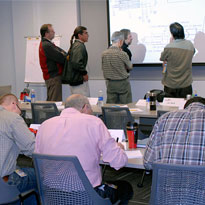LTE Air Interface Techniques
- Course:LTE Air Interface Techniques
- Course ID:LTEAI Duration:4 days Where: Your Office (7+ Persons)
- Download Course Description (PDF)
Available as a private, customized course for your group at your offices or ours and in some cases as a WebLive(TM) class.
Course Outline
- LTE/SAE Introduction
- Evolution of cellular networks
- 3GPP Releases (Release 99 to Release 8)
- EPS (E-UTRAN and EPC) logical architecture
- EPS interfaces
- EPC (Evolved Packet Core) architecture
- SAE/LTE interfaces
- Radio Interface Physical Layer Principles
- Propagation conditions
- Channel models
- Frequency selective channels
- Time dependent radio channels
- Multipath radio conditions: Delay, Doppler spectrum, multi-antenna channel model
- Dispersive channels: Drawbacks and design considerations
- Macrocell propagation model: Urban case
- Macrocell propagation model: Rural case
- Exercises
- Modulation principles
- BPSK, QPSK, 16QAM, 64QAM
- OFDM: Principles of operation
- MIMO system
- Exercises
- Coding and protection
- Turbo codes
- ARQ-HARQ principles
- Interleaving
- OFDM-SCFDMA
- OFDM principles
- OFDM time-frequency frame structure
- OFDM performance over dispersive channels
- MIMO overview
- MIMO principles of operation
- MU-MIMO and SU-MIMO
- MIMO implementation on LTE
- MIMO performance
- MIMO simulations
- Exercises
- LTE Radio Interface Techniques
- Radio Interface techniques: Uplink/downlink
- Radio channel structure
- Radio channel descriptions
- Radio interface
- Synchronization channels
- Exercises
- UE Transmitter/Receiver: Technical Characteristics
- Power transmission
- GSM and WCDMA short transmitter presentation
- Maximum Output Power (MOP)
- UE power classes
- Transmitter characteristics: Maximum Power Reduction (MPR), power control, MOP, transmit on/off power, out of synch output power, bandwidth requirements and allocation, out of band emission, spurious emission
- Receiver diversity characteristics
- Receiver sensitivity: Reference level, Maximum Sensitivity Reduction (MSR)
- Maximum input level
- Adjacent channel selectivity
- Blocking characteristics
- Inter-modulation characteristics
- Receiver performance
- Dual antenna receiver
- Physical Layer Procedures
- Synchronization procedures
- Timing synchronization
- Radio link monitoring
- Inter cell synchronization
- Inter Cell Interference Cancellation (ICIC) principles
- Power control: Uplink/downlink
- Random access procedures: Preample selection
- Channel quality: Channel Quality Indication (CQI) Report
- Precoding Matrix Indicators (PMI)
- Rank Indicator (RI)
- Propagation conditions
- Course Wrap-up : Recap and Discussion
Course in a Nutshell
This course will undertake an in-depth study of the LTE air interface. It will begin with a discussion of the radio channel environment and the related RF propagation issues to help you understand the problems that OFDM/MIMO solve. This is followed by a discussion of the modulation principles along with a detailed look at the LTE physical layer structure as it complements the modulation and MIMO channels. The transmitter and receiver parameters and techniques, based on the 3GPP specifications, are then presented. We conclude with a discussion of the physical layer procedures with emphasis on the channel quality and random access techniques.
Customize It!
- If you lack the necessary WCDMA/LTE background, we can teach an extended five-day course that includes WCDMA principles, LTE overview, and LTE air interface techniques.
- Add a workshop day at the end of the course, for a total of five days, for a deeper dive into capacity planning and coverage calculations.
Aimed At
Technical audiences with a good understanding of WCDMA/UMTS and prior exposure to LTE who wish to study the LTE air interface in depth.
Prerequisites
The UMTS course, or equivalent knowledge/experience, is required; the LTE Overview is recommended.
- "Nice presentation of LTE layer 1-2-3. Super job! Really enjoyed the practical explanations and insight." – Electrical Engineer, Fortune 500 Technology Company
- "Extensive info; instructor knowledgeable, experienced, personable, easy to understand. Course book has a lot of info, well structured, good color charts and tables." - Major US Defense Contractor

